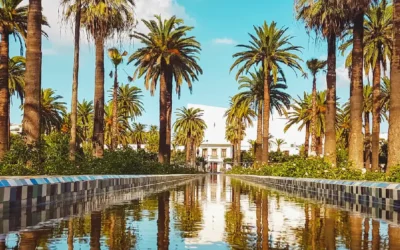Marrakech, The Red City Of Morocco

Table of Contents:
Introduction to Marrakech City
Marrakech, the fourth largest city in Morocco, also spelled Marrakesh, is one of the four Imperial cities, alongside Rabat, Fes, and Meknes, also one of the warmer regions in Morocco, is situated west of the foothills of the Atlas Mountains in Morocco. The city lies in the center of the fertile, irrigated Haouz Plain, south of the Tennsift River serves as a significant urban center, and holds a rich historical and cultural legacy as one of the country’s four imperial cities. Its strategic location and fertile grounds have contributed to its longstanding importance within the region.
As one of the four imperial cities of Morocco, Marrakech also serves as the capital of the Marrakesh–Safi region. This prestigious title reflects its historical significance and enduring influence within Morocco.
Being the chief city of central Morocco, Marrakech’s location in the Haouz Plain, a fertile and irrigated region, alongside its proximity to the Tennsift River, underscores its agricultural importance and the consequent economic sustenance it provides to the region. The city, with its distinctive red-pink buildings, ancient medina, and vibrant markets, continues to be a hub of cultural, economic, and agricultural activities, making it a cornerstone of Moroccan heritage and modern-day life.
Marrakech Discovery Tour
Embark on a journey through Marrakech, a city rich in history and culture, offering a myriad of attractions and activities awaiting tourists. Delve deeper into its major landmarks, museums, and cultural centers, and acquire official travel guidance to enhance your Marrakech experience.
Major Landmarks:
Medina Souks

Experience the charm of Marrakech’s Medina through its souks or markets, a captivating maze of narrow alleyways filled with shops that sell a variety of goods. Immerse yourself in a vibrant atmosphere while haggling over prices with local vendors.
Djemaa El Fna
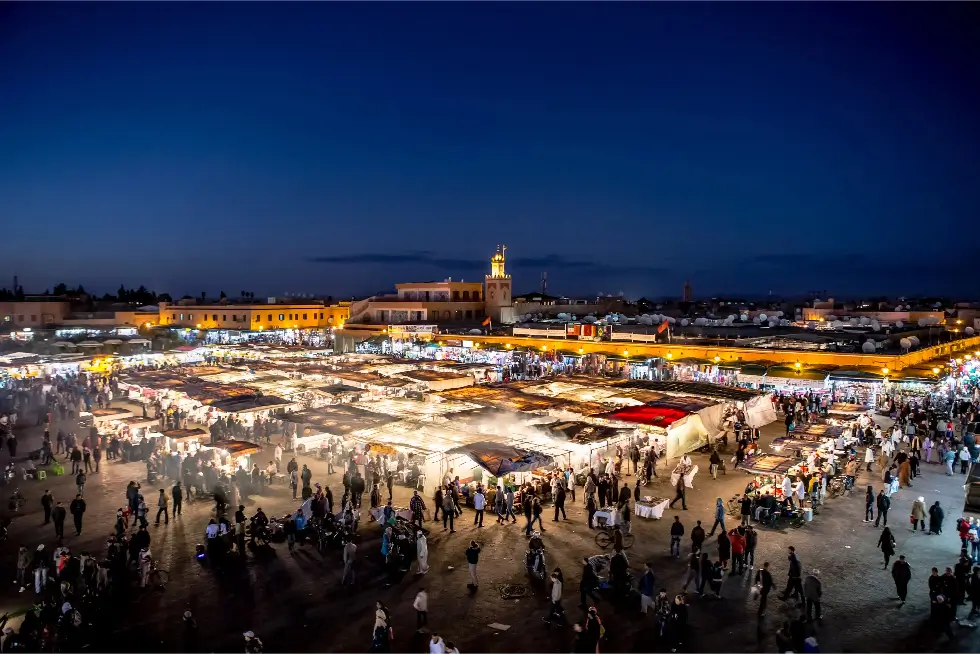
Known as the heart of Marrakech, Djemaa El Fna is a lively square brimming with musicians, acrobats, and food stalls, especially as the evening descends.
Riad Hotels

Revel in the unique lodging experience provided by Marrakech’s Riad hotels, boasting traditional architecture centered around tranquil courtyards.
Koutoubia Mosque
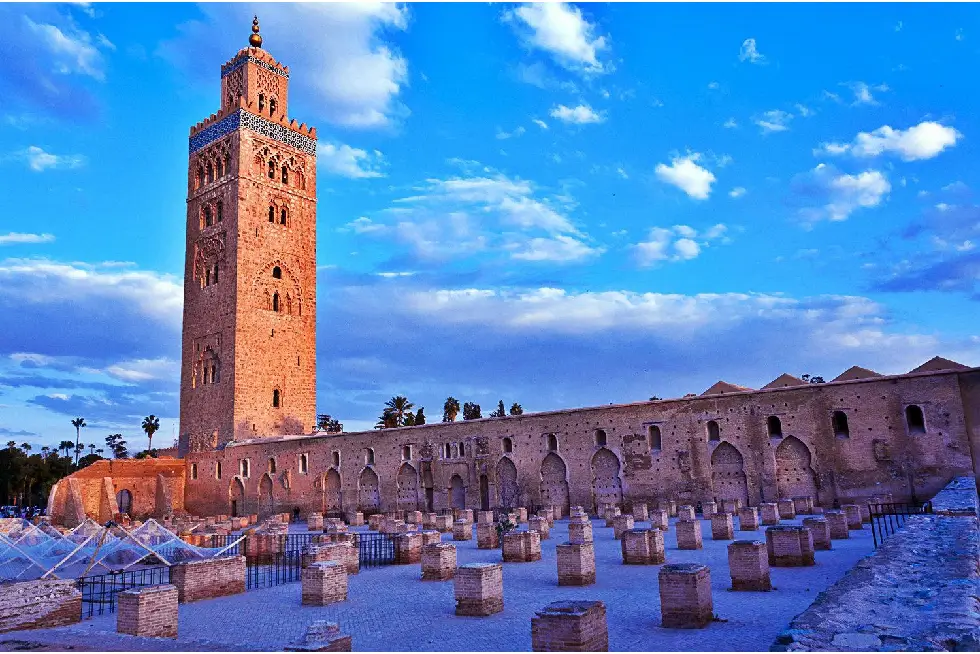
Visit the iconic Koutoubia Mosque, dating back to 1162, known for its 70-meter-tall minaret, a landmark visible throughout the city.
Majorelle Gardens

Explore the lush Majorelle Gardens, a creation of painter Jacques Majorelle, later owned by designer Yves Saint Laurent, renowned for its vibrant blue structures and a museum dedicated to Berber culture.
El Badi Palace and Saadian Tombs

Uncover Marrakech’s historical grandeur at the ruins of El Badi Palace and the nearby Saadian Tombs, both popular tourist sites.
Museums and Cultural Centers:
Marrakech Museum

Witness a wide array of Moroccan cultural artifacts including pottery, metals, and textiles at the Marrakech Museum.
Dar Si Said Museum
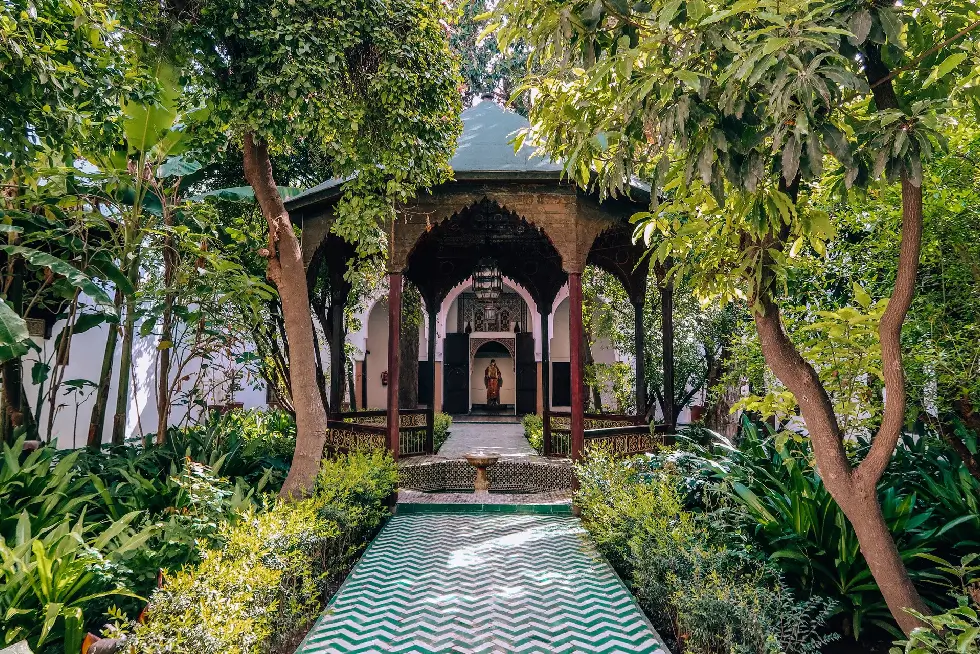
Venture into Dar Si Said Museum, another significant cultural hub, to discover more about Marrakech’s heritage.
Museum of the Palmery

Experience the blend of nature and art at the Museum of the Palmery, encompassing beautiful gardens and an art museum displaying modern Moroccan works.
Maison de la Photographie

Step back in time at Maison de la Photographie, offering a glimpse into historical Marrakech through a vast collection of photographs taken between 1870 and 1960.
Best Things to Do:
Engage in a variety of activities like exploring the serene gardens like Jardin Majorelle, visiting the modern districts of Gueliz & Ville Nouvelle, and soaking up the lively atmosphere at Djemaa El Fna. These experiences allow visitors to appreciate both the traditional and contemporary facets of Marrakech.
Marrakech Transportation
Marrakech offers a range of transport options including taxis, city buses, and Tuk-tuks, mainly within the Medina. The ALSA city buses operate both within and around 30 km outside the city, with routes starting from areas like “Sidi Mimoun”.

Taxis are a common mode of transport, with prices for journeys within the city center ranging between 20 dh and 30 dh. Tuk-tuks, originally from Asia, offer tours within the Medina at negotiated prices. Additionally, from Marrakech-Menara airport, travelers can reach the city center via ALSA urban network shuttles or taxis.
Marrakech Cultural Overview
Marrakech, recognized for its affluent historical and cultural legacy, presents a distinctive amalgam of age-old and modern cultural manifestations. Below is a summarization of the cultural facets as delineated in the given outline:
Music, Theatre, and Dance:
Music

Traditional music plays a pivotal role in the cultural life of Marrakech. The city’s musical heritage is a melodic blend of Berber, Arab, and Andalusian influences. A notable musical tradition is the Dakka Marrakchia, a unique style of ritual music and dance from Marrakech, celebrated during various festivals and ceremonies across the city.
Theatre
Marrakech boasts a vibrant theatre scene, offering a rich array of both classical and modern performances that reflect the city’s historical and contemporary cultural narratives.
Dance
The dance traditions in Marrakech are a colorful display of the city’s Berber and Arab roots, each style telling a story of its diverse cultural heritage.
Crafts:

Marrakech is a treasure trove of crafts, nurturing a thriving artisan community skilled in pottery, leatherwork, metalwork, and textile creation. The city’s craft markets are a testament to its rich artisanal heritage, offering a glimpse into the age-old techniques passed down through generations.
Festivals:

The city’s festivals are a lively celebration of Marrakech’s cultural richness. Key events include the Marrakech International Film Festival and the Marrakech Festival of Popular Arts, both of which provide a platform for showcasing traditional Moroccan music, dance, and folklore, alongside international cinematic works.
Food:

Marrakech’s culinary scene is a feast for the senses. From traditional dishes like tagines, couscous, and pastilla to the bustling street food culture, the city offers a rich palette of flavors that reflect its diverse cultural influences.
Architecture:
The architectural landscape of Marrakech is a vivid reflection of its cultural diversity. The city’s splendid palaces, mosques, and traditional layouts showcase the harmonious blend of Berber, Arab, and French architectural styles.
The cultural fabric of Marrakech is deeply intertwined with its Berber heritage, which resonates through the city’s language, music, and traditions. The amalgamation of Berber culture with Arab and Islamic influences creates a unique cultural milieu that captivates visitors from across the globe.
Marrakech Economy And Tourism Overview
Marrakech, known as the Red City, is a vibrant economic and cultural hub located in the center of Morocco. The city’s economy is a blend of traditional and modern sectors, with a strong emphasis on tourism, handicrafts, and trade. Key industries also include agri-food and construction.

Tourism Impact and Growth
Tourism is a major driver of Marrakech’s economy, significantly impacting its territorial development. The sector brings substantial economic benefits, although managing the associated social and environmental challenges is crucial for sustainable growth. Marrakech attracts over two million tourists annually, thanks to improved connectivity via highways to other cities like Casablanca and Agadir, and the local airport.
The city has set ambitious tourism growth targets, aiming to attract 20 million tourists to Morocco annually by 2020. Known as the tourist capital of Morocco, Marrakech’s rich history, cultural identity, and hospitality have made it a desirable destination for travelers, including the European jet set, contributing to its status as a must-visit city in the country.
Real Estate and Hotel Development
The last two decades saw a significant increase in real estate and hotel development in Marrakech, catering to both local and international investors. By 2005, over 3,000 foreigners had purchased properties in the city, drawn by its cultural allure and relatively affordable housing prices. The influx of foreign investments, particularly from French celebrities and moguls, has further boosted the city’s real estate sector, transforming Marrakech into a fashionable destination akin to St. Tropez in France.
Economic Challenges
Despite the tourism boom and economic growth, a significant portion of Marrakech’s population remains impoverished, with around 20,000 households lacking access to basic amenities like water or electricity as of 2010. Moreover, several enterprises in the city are grappling with substantial debt issues. The city’s diverse economy, coupled with its rich cultural heritage and strategic location near two port cities and the Grand Atlas mountain range, continues to foster its growth and position on the global tourism map.
Marrakech History Overview
Marrakech stands as a timeless testament to Morocco’s rich cultural and architectural heritage. Its journey from a strategic Berber settlement to the metropolis reflects the enduring allure and historical significance it holds in the tapestry of Moroccan civilization.
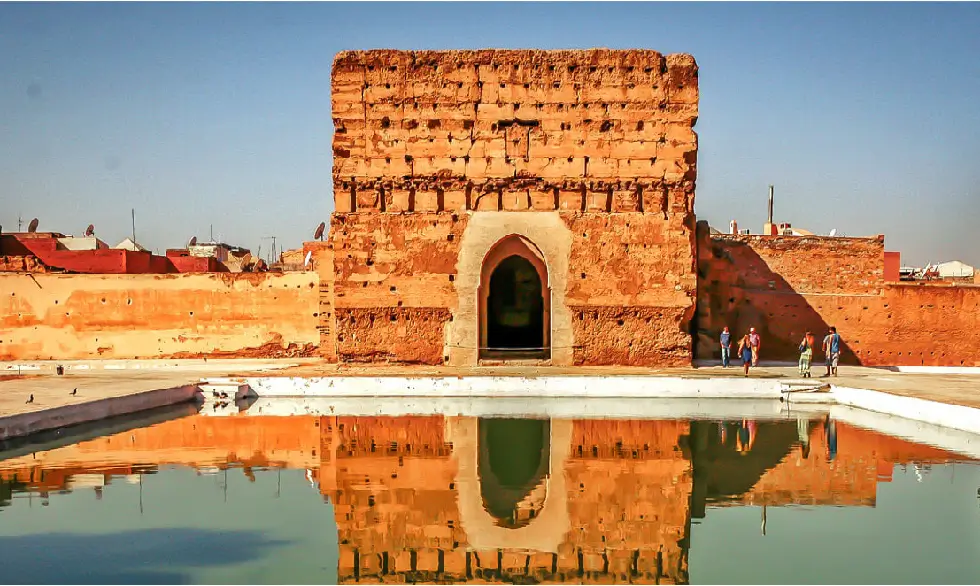
A. Etymology and Founding
The name Marrakech is derived from the Berber words amur (n) akush, which translates to “Land of God.” The city was founded between 1070 and 1072 AD by the Almoravids, a Berber dynasty. Under the leadership of Abu Bakr ibn Umar, the establishment of Marrakech marked the beginning of a significant chapter in Moroccan history.
B. Historical Significance:
The first of Morocco’s four imperial cities
Marrakech has the honor of being the first among Morocco’s four imperial cities, with the others being Fes, Meknes, and Rabat. Its foundation laid the groundwork for a thriving political, economic, and cultural hub that significantly influenced the trajectory of the region.
UNESCO World Heritage site, designated in 1985 due to its ancient medina
Recognizing its historical and cultural value, UNESCO designated the Medina of Marrakech as a World Heritage site in 1985. The ancient medina is a living testament to traditional Moroccan urban architecture, with its labyrinthine alleys, historic structures, and bustling markets offering visitors a tangible link to the city’s illustrious past.
Conclusion
Marrakech, a jewel of Morocco, captures the essence of the country’s vibrant culture and rich historical tapestry. Its allure stems from the blend of traditional and modern experiences, evident in the bustling souks, grandiose palaces, and enduring architectural marvels. The city’s significance lies in its role as a cultural, economic, and historical hub, offering a window into Morocco’s past and a taste of its contemporary spirit. Marrakech’s unique character and allure continue to captivate residents and visitors alike, reinforcing its status as a must-visit destination within Morocco.
FAQ
Are there any notable museums or cultural centers in Marrakech?
Yes, Marrakech hosts several museums and cultural centers like the Marrakech Museum, Dar Si Said Museum, Museum of the Palmery, and Maison de la Photographie.
What does the name ‘Marrakech’ mean?
The name ‘Marrakech’ is derived from the Berber words ‘amur (n) akush,’ which means “Land of God.”
What is Marrakech known for?
Marrakech is known for its rich historical and cultural legacy, being one of Morocco’s four imperial cities. It’s famous for its distinctive red-pink buildings, ancient medina, vibrant markets, and a mix of traditional and modern Moroccan life.
Where is Marrakech located?
Marrakech is located west of the Atlas Mountains in Morocco, in the center of the fertile, irrigated Haouz Plain, south of the Tennsift River.
What is the significance of Marrakech in Morocco?
As one of Morocco’s four imperial cities, Marrakech is a significant urban center with historical importance and enduring influence within Morocco. It plays a key role in the country’s cultural, economic, and agricultural sectors.
What are the major landmarks in Marrakech?
Key landmarks include Medina Souks, Djemaa El Fna, Koutoubia Mosque, Majorelle Gardens, El Badi Palace, and Saadian Tombs.
What activities can tourists engage in in Marrakech?
Tourists can explore gardens, visit historical sites, enjoy local markets, and experience the city’s vibrant culture in areas like Djemaa El Fna.
What are the accommodation options in Marrakech?
Marrakech offers various accommodation options, including unique Riad hotels known for their traditional architecture and tranquil courtyards.
How can tourists navigate around Marrakech?
Marrakech offers taxis, city buses, and Tuk-tuks for transportation, especially within the Medina. The ALSA city buses and taxis are also available for longer distances.
Is there an official travel guide or tourist office for Marrakech?
Yes, tourists can refer to the official website of Marrakech’s tourist office for comprehensive information on attractions, accommodations, and travel tips.
Can you describe the cultural heritage of Marrakech?
Marrakech has a rich cultural heritage that includes traditional music, theatre, dance, crafts, and a variety of festivals showcasing its Berber, Arab, and Andalusian influences.
What are the popular festivals in Marrakech?
Notable festivals include the Marrakech International Film Festival and the Marrakech Festival of Popular Arts.
What is the architectural style of Marrakech?
Marrakech features a mix of Berber, Arab, and French architectural styles, evident in its palaces, mosques, and traditional city layouts.
What is the economic landscape of Marrakech?
Marrakech’s economy is diversified, focusing on tourism, handicrafts, trade, agri-food, and construction. Tourism is a major driver, with significant contributions to the city’s development.
How does tourism impact Marrakech’s economy?
Tourism significantly impacts Marrakech’s economy and territorial development, with challenges in managing social and environmental aspects for sustainable growth.
What is the historical significance of Marrakech?
Founded by the Almoravids in the 11th century, Marrakech is the first of Morocco’s four imperial cities and is a UNESCO World Heritage site. It has played a pivotal role in Moroccan history as a political, economic, and cultural hub.


